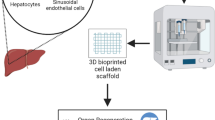Abstract
The cultured hepatic cells in vitro are prone to losing their characteristic morphologies and biological functions. To avoid this problem, a hybrid co-culture system was proposed to elucidate the effect of cellular communication on the phenotype of hepatic cells. A monolayer of endothelial cells (ECs) was co-cultured on the surface of a three-dimensional (3D) scaffold embedded with HepG2 cells. In this hybrid co-culture system, the growth of encapsulated hepatic cells is barely influenced by the co-cultured ECs. However, the liver-special functions of hepatic cells, including the albumin secretion and the expression levels of hepatocyte-specific genes, are significantly improved. It is deduced that the improved liver-special functions is likely related to the paracrine mechanisms. Hence, this hybrid co-culture model may open a window for the co-cultivation of the multi-type of cells as well as the study of cell-cell signaling interaction.
Graphical Abstract








Similar content being viewed by others
References
Hammond JS, Beckingham IJ, Shakesheff KM. Scaffolds for liver tissue engineering. Expert Rev Med Devices. 2006;3(1):21–7.
Tripathi A, Melo JS. Preparation of a sponge-like biocomposite agarose–chitosan scaffold with primary hepatocytes for establishing an in vitro 3D liver tissue model. RSC Adv. 2015;5(39):30701–10.
Bokhari M, Carnachan RJ, Cameron NR, et al. Culture of HepG2 liver cells on three dimensional polystyrene scaffolds enhances cell structure and function during toxicological challenge. J Anat. 2007;211(4):567–76.
Perret B, Mabile L, Martinez L, et al. Hepatic lipase structure/function relationship, synthesis, and regulation. J Lipid Res. 2002;43(8):1163–9.
Baccarani U, Sanna A, Cariani A, et al. Cryopreserved human hepatocytes from cell bank: in vitro function and clinical application. Transplant Proc Elsevier. 2005;37(1):256–9.
Yamamoto N, Wu J, Zhang Y, et al. An optimal culture condition maintains human hepatocyte phenotype after long-term culture. Hepatol Res. 2006;35(3):169–77.
Allen JW, Bhatia SN. Improving the next generation of bioartificial liver devices. Semin Cell Dev Biol. 2002;13(6):447–54.
Dich J, Vind C, Grunnet N. Long‐term culture of hepatocytes: effect of hormones on enzyme activities and metabolic capacity. Hepatology. 1988;8(1):39–45.
Kang YBA, Sodunke TR, Lamontagne J, et al. Liver sinusoid on a chip: Long‐term layered co‐culture of primary rat hepatocytes and endothelial cells in microfluidic platforms. Biotechnol Bioeng. 2015;112(12):2571–82.
Liu Y, Li H, Yan S, et al. Hepatocyte cocultures with endothelial cells and fibroblasts on micropatterned fibrous mats to promote liver-specific functions and capillary formation capabilities. Biomacromolecules. 2014;15(3):1044–54.
Nathan MR, Kostaras L, Bridgeman V, et al. Dissectingthe mechanisms of hepatocyte replacement in breast cancer liver metastases. Cancer Res. 2016;76(14 Supplement):4105.
Seo SJ, Kim IY, Choi YJ, et al. Enhanced liver functions of hepatocytes cocultured with NIH 3T3 in the alginate/galactosylated chitosan scaffold. Biomaterials. 2006;27(8):1487–95.
Lai YH, Fan SK. Constructung 3D cell-laden hydrogels on electromolding. 2015 Transducers-2015 IEEE of 18th International conference on solid-state sensors, actuators and microsystems (Transducers). 2015: 1865–8.
Jeong D, Han C, Kang I, et al. Effect of concentrated fibroblast-conditioned media on in vitro maintenance of rat primary hepatocyte. PLoS One. 2016;11(2):e0148846.
Kang YBA, Rawat S, Cirillo J, et al. Layered long-term co-culture of hepatocytes and endothelial cells on a transwell membrane: toward engineering the liver sinusoid. Biofabrication. 2013;5(4):045008.
Salerno S, Morelli S, Drioli E, et al. Biofabrication of layered membrane systems by using human hepatocytes and endothelial cells: a comparative study. Curr Tissue Eng. 2013;2(2):109–18.
Lu YC, Song W, An D, et al. Designing compartmentalized hydrogel microparticles for cell encapsulation and scalable 3D cell culture. J Mater Chem B. 2015;3(3):353–60.
Bhatia SN, Balis UJ, Yarmush ML, et al. Effect of cell–cell interactions in preservation of cellular phenotype: cocultivation of hepatocytes and nonparenchymal cells. FASEB J. 1999;13(14):1883–1900.
Zervantonakis IK, Kothapalli CR, Chung S, et al. Microfluidic devices for studying heterotypic cell-cell interactions and tissue specimen cultures under controlled microenvironments. Biomicrofluidics. 2011;5(1):013406.
Yang Y, Li J, Pan X, et al. Co‐culture with mesenchymal stem cells enhances metabolic functions of liver cells in bioartificial liver system. Biotechnol Bioeng. 2013;110(3):958–68.
Shang Y, Tamai M, Ishii R, et al. Hybrid sponge comprised of galactosylated chitosan and hyaluronic acid mediates the co-culture of hepatocytes and endothelial cells. J Biosci Bioeng. 2014;117(1):99–106.
Hansen NUB, Genovese F, Leeming DJ, et al. The importance of extracellular matrix for cell function and in vivo likeness. Exp Mol Pathol. 2015;98(2):286–94.
Kim D, Seo Y, Kwon S. Role of gap junction communication in hepatocyte/fibroblast co-cultures: Implications for hepatic tissue engineering. Biotechnol Bioprocess Eng. 2015;20(2):358–65.
Can UI, Nagarajan N, Zorlutuna P. Microfabrication of patterned co-cultures for controllable cell–cell interfaces. Microscale technologies for cell engineering. Springer International Publishing Switzerland, 2016: 47–67.
Huang X, Zhang X, Wang X, et al. Microenvironment of alginate-based microcapsules for cell culture and tissue engineering. J Biosci Bioeng. 2012;114(1):1–8.
Bhatia SN, Balis UJ, Yarmush ML, et al. Effect of cell–cell interactions in preservation of cellular phenotype: cocultivation of hepatocytes and nonparenchymal cells. FASEB J. 1999;13(14):1883–900.
Acknowledgements
This work has been supported by the National Natural Science Foundation of China (31300808, 31400815), Scientific and Technological Innovation Programs of Higher Education Institutions in Shanxi (201417), Chinese Government Scholarship (NO. 201508140048) and Shanxi Scholarship Council of China (2013-030).
Author information
Authors and Affiliations
Corresponding authors
Ethics declarations
Conflict of interests
The authors declares that they have no competing interests.
Rights and permissions
About this article
Cite this article
Yang, X., Wang, X., Huang, X. et al. A hybrid co-culture model with endothelial cells designed for the hepatic tissue engineering. J Mater Sci: Mater Med 28, 139 (2017). https://doi.org/10.1007/s10856-017-5950-3
Received:
Accepted:
Published:
DOI: https://doi.org/10.1007/s10856-017-5950-3




